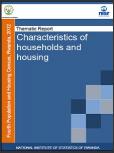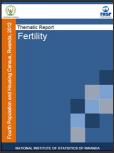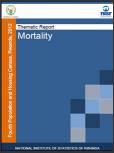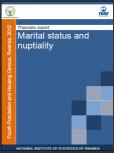RPHC4 Thematic Report: Measurement and Mapping of Non-Monetary Poverty
At national level, 1,050,135 people are found to be severely poor and 2,818,321 moderately poor, so the total number of poor people is 3,868,456. Within the population with sufficient available data this represents 37%.
RPHC4 Thematic Report: Characteristics of Households and Housing
This report focuses on two interlinked topics. On the one hand, it looks at households’ characteristics and, on the other hand, at the characteristics of the households they live in. The report is organised into 10 main chapters, the first two of which provide the reader with an overview of the Census process and the context leading up to the analysis of the Census data and the production of the report. Chapters 3 through 6 review the characteristics of Rwandan households and chapters 7 through 10 review the characteristics of households.
RPHC4 Thematic Report: Population Size, Structure and Distribution
The Fourth Rwanda Population and Housing Census (RPHC4) establish that the population of Rwanda is 10,515,973 residents, of which 52% are women and 48% men. Since the 2002 Census, the population has increased by 2.4 million, which represents an average annual growth rate of 2.6%. Thus, population growth has recovered its long-term rate following the decline in the 1990s, which were marked by the war and the genocide against the Tutsi.
RPHC4 Thematic Report: Migration and Spatial Mobility
whose place of birth is not the same as the current place of residence, and recent migration, i.e. persons who moved to their current district of residence five years or less prior to the Census. The data indicate that migration
RPHC4 Thematic Report: Fertility
The objectives of the present report are to estimate the current levels of fertility, trends over time, geographical and socio-economic variations in fertility in Rwanda. The three main findings of the analysis are:
RPHC4 Thematic Report: Mortality
The objective of the present analysis was to analyse the level, trends and pattern of: (i) mortality among the general population; (ii) early childhood mortality; (iii) adult mortality; and (iv) mortality among the elderly. The main findings is that mortality remains generally high in Rwanda but has decreased substantially over time, especially among children aged 0.
RPHC4 Thematic Report: Marital status and Nuptiality
The analysis of marital status and nuptiality is important in helping us to understand the dynamics of a society and how it changes over time. Marriage is an important factor in regard to fertility, especially in Rwanda where thelarge majority of children are born in wedlock.
The results of the Fourth Rwanda Population and Housing Census (RPHC4) show that nearly half of the population aged 12 and above is married. However, between 1978 and 2012 the percentage of married people has decreased.

![[title]](https://statistics.gov.rw/sites/default/files/styles/pub_small_112x150_/public/publications/dbbad719-7b6a-41ec-919e-63cb1b8c6707/measurement_mapping.jpg?itok=yFNQEPQw)


![[title]](https://statistics.gov.rw/sites/default/files/styles/pub_small_112x150_/public/publications/38e203c4-2230-476d-81ae-7f8690183b15/migration_spatial_mor.jpg?itok=BuLoptO3)



![[title]](https://statistics.gov.rw/sites/default/files/styles/pub_small_112x150_/public/publications/2d167973-f1a0-4ae1-94ec-eb4ede70d6f7/cover_census.jpg?itok=_tKkDibW)